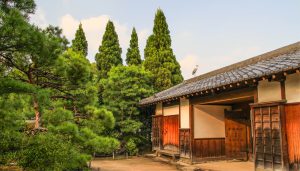Honshu, Japan’s largest and centrally located island, is a mountainous area that is still susceptible to volcanic and seismic activity. There are important climatic differences between the lower and higher zones and between the west and east of the island. Ocean currents in the Sea of Japan bring warmer weather to the west, while the east of the island is more subject to the cold ‘Chishima’ current from the Bering Sea. Arboretum Group 39 provides a picture of the forests on Honshu, from south to north. Japanese red pine and Japanese black pine are common in the coastal strips of the warmer south. Deciduous forests of oak species grow on richer soils, where it is common to find Daimyo oak, Siebold’s beech and species in the genus Castanopsis. Silver firs and other conifers begin to appear as one moves higher up the moderately warm mountain forests, trees that we have already encountered on Mount Fuji. In the temperate cold forest of the eastern ridges and the subalpine forest of the highest zones, fir and silver fir as well as larch prevail. This zone also contains some rare endemic species: Thujopsis dolabrata, the sole species of the genus Thujopsis, and Koyama’s spruce, which can be found in subgroup 39C. In previous decades, Japanese cedar and Japanese larch were planted in abundance in group 39 to compare the growth and resilience of these species, resulting in quite a realistic image of the actual Honshu forests, because plantations of these two species have largely replaced the old-growth forests. Visitors are encouraged to take note of the elegant trees in the back of the group, along the old Kapucijnenvijverdreef, where, among other species, fifteen species of maple are located.


